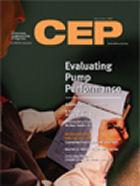|
Literature / Source Database:
Chemical Engineering Progress
Description
publication of the American Institute of Chemical Engineers (AIChE)
| Title (short) |
Chem. Eng. Progr. |
| Title (abbrev) |
CEP |
| CODEN |
CEPRA8 |
| Languages |
English |
| First year |
1947 |
| Impact factor |
0.364 |
|
|

|
Status
active
Subject

Source type
Journal
Publisher
ISBN ISSN
0360-7275
First volume
97
Last volume
104+
Publish city
New York
Homepage
| Resources |
|
Availability |
|
|
|
|
|
| Text PDF |
 |
free access |
 |
| Text Html |
 |
for subscriber |
 |
| References |
 |
not available |
 |
| Abstracts |
 |
|
|
| TOC |
 |
|
|
|
|
|
|

Description
Chemical Engineering Progress (CEP) is the flagship publication of the American Institute of Chemical Engineers (AIChE), the world's leading organization for chemical engineers. Over 32,000 professionals receive the magazine each month. According to CEP’s latest demographic statistics, nearly 85% of these influential readers work in industry, with the rest employed in academia and government. CEP's mandate is to provide essential technical and professional information to this key audience. What Types of Articles Does CEP Seek? CEP publishes articles on the key aspects of chemical engineering, such as:- Career Development
- Environmental Management
- Fuels and Energy
- Fluids and/or Solids Handling
- Information Technology
- Management
- Materials
- Measurement and Control
- Reactions and Separations
- Safety
CEP's strives to publish impartial, generic articles that provide "how-to" guidance to the practicing chemical engineer, or an overview of some type of technology. CEP looks for articles that focus on the general chemical engineering problem or situation and the generic method of solving that problem, rather than on what was done in a particular instance to solve a specific problem. We do not publish case histories. However, an article can use information from actual installations to illustrate specific points, but it should not turn into a series of case histories. Appropriate subjects for articles include: choosing among design or equipment options; troubleshooting a process unit; designing specific plant hardware; assessing the likely impact of emerging technology; reviewing key trends and challenges in engineering research and development; evaluating continuing-education needs; and much, much more.
|